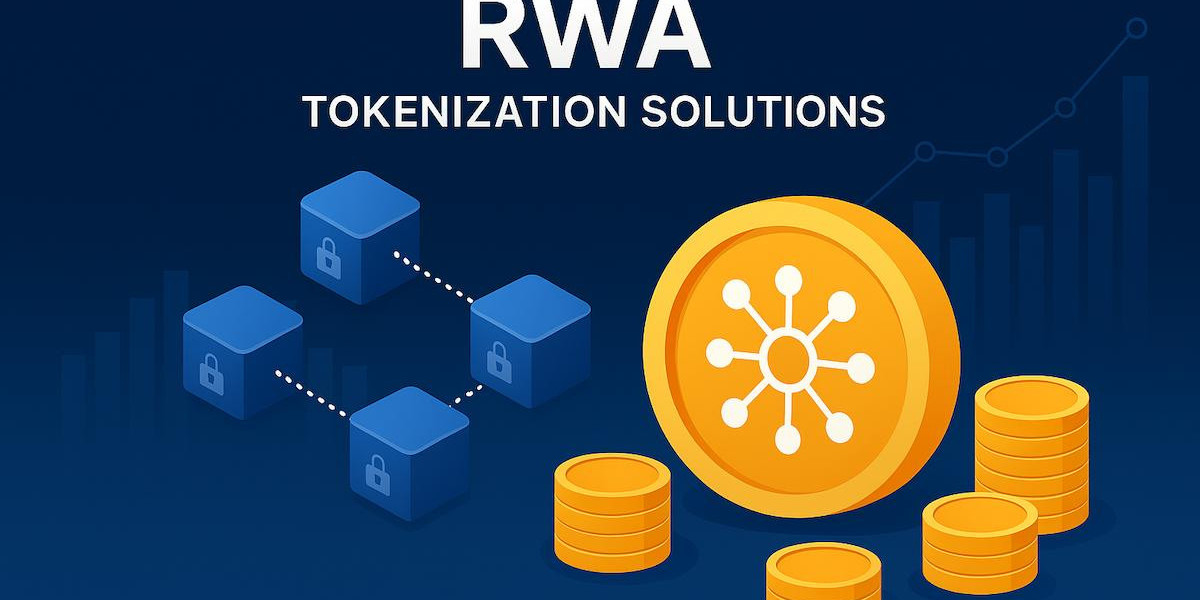The tokenization of real-world assets (RWA) has become one of the most transformative innovations in blockchain and digital finance. By bridging tangible assets like real estate, commodities, bonds, or luxury goods with blockchain technology, RWA tokens are reshaping how ownership, liquidity, and investment are managed. In 2025, the demand for RWA tokenization is accelerating as institutions, investors, and startups explore new opportunities for financial inclusion, fractional ownership, and borderless transactions.
Launching RWA tokens is not just about creating a digital representation of a physical asset it requires careful planning, regulatory compliance, technical expertise, and market strategies to ensure success. This guide provides a step-by-step breakdown of how to launch RWA tokens in 2025, covering everything from understanding token fundamentals to compliance, smart contracts, security, and global adoption strategies.
Understanding RWA Tokens in 2025
RWA tokens represent digital ownership of physical or financial assets recorded securely on a blockchain. Unlike cryptocurrencies with no intrinsic backing, RWA tokens derive their value from tangible assets like real estate properties, corporate debt, carbon credits, or gold. These tokens enable fractional ownership, allowing investors to participate with smaller amounts while ensuring transparency through blockchain’s immutable record-keeping.
In 2025, the RWA token landscape has matured significantly. With institutional adoption on the rise, regulatory clarity improving, and investor interest expanding globally, launching RWA tokens is now more practical than ever. The ecosystem now includes specialized tokenization platforms, custody providers, and DeFi integrations that streamline the issuance and trading of RWA tokens.
Step 1: Defining the Asset for Tokenization
The first and most critical step is deciding which real-world asset you want to tokenize. The choice determines your target audience, compliance requirements, and the technical model you will adopt.
Assets that are commonly tokenized include:
Real estate (commercial buildings, residential properties, land)
Commodities (gold, oil, agricultural products)
Debt instruments (corporate bonds, government securities)
Luxury items (art, collectibles, cars, watches)
Environmental assets (carbon credits, renewable energy certificates)
When selecting the asset, consider factors such as liquidity, demand, market size, and investor accessibility. For example, tokenizing real estate enables investors worldwide to own fractions of high-value properties that were previously accessible only to wealthy individuals or institutions.
Step 2: Conducting Market Research and Feasibility Analysis
Before launching an RWA token, thorough market research and feasibility analysis are essential. This involves evaluating the investment potential, legal complexities, and competitive landscape surrounding your chosen asset.
Conducting feasibility includes:
Assessing market demand: Identify whether your target audience (retail or institutional investors) is actively seeking exposure to the asset.
Legal due diligence: Determine if the asset has clear ownership rights, no disputes, and a transparent valuation mechanism.
Competitor analysis: Analyze existing RWA token projects, their strengths, and weaknesses to identify your unique value proposition.
A well-prepared feasibility study not only strengthens investor confidence but also helps avoid regulatory hurdles and market misalignment later in the project.
Step 3: Structuring the RWA Token Model
Once you have validated your asset choice, the next step is to design the token model. This includes decisions about the type of token, its functionality, and governance.
There are generally three tokenization models:
Equity-based tokens: Represent partial ownership in the asset. For example, investors in tokenized real estate receive dividends from rent.
Debt-based tokens: Represent rights to repayment, such as tokenized bonds or loans.
Utility-based tokens: Provide access to services or rights related to the asset ecosystem, often used in hybrid models.
Defining the token model ensures clarity for investors. You’ll need to decide how dividends, interest, or profits will be distributed, and how the governance framework will operate (centralized vs. decentralized).
Step 4: Ensuring Regulatory and Legal Compliance
One of the most challenging yet vital steps in RWA token launches is regulatory compliance. Since these tokens are backed by real-world assets, they often fall under securities, commodities, or property laws, depending on jurisdiction.
In 2025, regulations are more defined in regions like the US, EU, Singapore, and the UAE, with frameworks tailored to asset-backed tokenization. Key considerations include:
Securities laws: Many RWA tokens are considered securities, requiring compliance with SEC (US), ESMA (EU), or similar bodies.
AML/KYC procedures: Token issuers must ensure Anti-Money Laundering and Know-Your-Customer compliance to avoid illicit use.
Cross-border rules: Since investors may participate globally, aligning with multiple jurisdictions is critical.
Working with legal advisors and compliance specialists is non-negotiable. A compliant launch not only protects your business but also builds investor trust.
Step 5: Choosing the Blockchain Platform
The blockchain infrastructure determines your token’s scalability, liquidity, and interoperability. In 2025, several blockchain networks have positioned themselves as leaders in RWA tokenization due to speed, cost-efficiency, and regulatory acceptance.
Popular platforms include:
Ethereum: Known for its mature ecosystem, though high gas fees remain a challenge.
Polygon: A scalable Layer-2 solution offering low-cost transactions.
Avalanche: Offers high throughput and customizable subnets for compliance-driven token projects.
Solana: Known for speed and efficiency, ideal for high-frequency trading of tokenized assets.
Private blockchains: Platforms like Hyperledger or Corda are preferred for enterprise-grade tokenization with controlled environments.
Choosing the right blockchain requires balancing scalability, security, regulatory adaptability, and ecosystem adoption.
Step 6: Developing Smart Contracts
Smart contracts are the backbone of RWA tokens, automating issuance, transfers, dividend payouts, and compliance checks. These self-executing codes ensure transparency and reduce reliance on intermediaries.
Key features of smart contracts for RWA tokens include:
Asset verification and proof of ownership
Fractional ownership and transfer management
Automatic dividend or interest distribution
Compliance integration for KYC/AML
Governance mechanisms for investor voting
In 2025, advancements in smart contract security and auditing have minimized risks of vulnerabilities. Still, hiring experienced blockchain developers and conducting third-party audits are critical to prevent breaches.
Step 7: Integrating Custody and Asset Management Solutions
Since RWA tokens represent physical or financial assets, custody is a critical component. Investors need assurance that the real-world asset is securely stored, insured, and legally protected.
There are two main custody approaches:
Centralized custody: Assets are held by a trusted custodian (banks, licensed custodians).
Decentralized custody: Assets are tokenized with decentralized governance, though legal enforcement may still rely on centralized entities.
Asset managers and custodians play a key role in ensuring that the token value always reflects the underlying asset. Without reliable custody, investor confidence may collapse.
Step 8: Designing Tokenomics and Distribution Strategy
Tokenomics defines the financial logic of your RWA token ecosystem. This includes supply, pricing, distribution, and reward mechanisms.
Key considerations:
Supply model: Fixed supply (for a building) or dynamic (for recurring debt instruments).
Distribution strategy: Will tokens be sold via private placements, public offerings, or through DeFi platforms?
Incentives: Staking rewards, early-bird discounts, or loyalty programs can attract investors.
A transparent tokenomics model is vital for long-term sustainability and liquidity. It helps investors understand returns, risks, and governance rights.
Step 9: Building a User-Friendly Platform
Investors need a secure, simple, and intuitive way to buy, sell, and manage their RWA tokens. Developing a user-friendly platform is crucial for adoption.
Core features of an RWA token platform include:
Wallet integration: Secure multi-chain wallet support for easy storage and transfer.
Trading interface: Secondary market access for buying/selling tokens.
Compliance automation: KYC/AML verification within the platform.
Analytics dashboard: Real-time asset performance and dividend tracking.
Partnering with professional blockchain development companies can help build scalable, secure, and compliant platforms tailored to your needs.
Step 10: Launching the RWA Token Offering
After building the infrastructure, the next step is launching the token offering. This is where your project goes public, and investors gain access to the tokenized asset.
Key steps include:
Private sale/Pre-launch: Secure early investors to establish credibility and liquidity.
Public sale/IDO/IEO: Open token sales to the broader public, often via exchanges or DeFi platforms.
Exchange listing: Partner with centralized or decentralized exchanges for secondary market liquidity.
A well-planned launch strategy ensures you raise sufficient capital, generate awareness, and attract long-term investors.
Step 11: Marketing and Community Building
Launching a successful RWA token isn’t only about technology it’s also about building trust and awareness. Marketing and community engagement drive adoption.
Effective strategies in 2025 include:
Content marketing: Publish whitepapers, blogs, and explainer videos on RWA benefits.
Influencer collaborations: Partner with thought leaders in crypto and finance.
Community engagement: Build active Telegram, Discord, and X (Twitter) groups to interact with investors.
PR campaigns: Share milestones, compliance certifications, and investor success stories to establish credibility.
Transparency and consistent updates are crucial for maintaining investor confidence.
Step 12: Post-Launch Management and Governance
Launching is only the beginning. The real challenge lies in maintaining your token ecosystem and ensuring sustainable growth.
Post-launch activities include:
Ongoing asset valuation: Regular third-party audits and reports to confirm token value.
Governance: Implement DAO or centralized governance to allow investor participation in decisions.
Liquidity management: Ensure trading volume and liquidity pools for easy buying/selling.
Compliance updates: Stay aligned with evolving global regulations.
A successful RWA token is one that not only launches smoothly but also sustains investor trust in the long term.
Challenges in Launching RWA Tokens
Despite their potential, RWA tokens face challenges:
Regulatory uncertainty in certain regions.
Complex asset valuation processes.
Custody risks with physical asset storage.
Liquidity limitations if secondary markets are underdeveloped.
However, with the right strategy, expert partners, and adherence to best practices, these challenges can be mitigated.
The Future of RWA Tokenization in 2025 and Beyond
By 2025, RWA tokens are no longer experimental—they are becoming a mainstream investment vehicle. From tokenized government bonds to sustainable energy credits, the scope is expanding rapidly. Institutional players are entering the space, bringing with them compliance standards and massive liquidity.
In the near future, we may see fully regulated tokenized stock markets, integrated global property exchanges, and tokenized commodities replacing traditional futures markets. For businesses and investors, launching RWA tokens today provides first-mover advantages in a trillion-dollar market.
Conclusion
Launching RWA token development in 2025 is an exciting opportunity to merge traditional finance with blockchain innovation. From selecting the right asset and conducting feasibility studies to ensuring compliance, building smart contracts, and marketing the offering, every step requires careful planning and execution.
RWA tokens are more than a technological advancement they are a paradigm shift in how we perceive ownership, investment, and liquidity. By following this step-by-step guide, businesses and entrepreneurs can successfully launch RWA tokens, unlock new revenue streams, and pave the way for a more inclusive global financial system.














